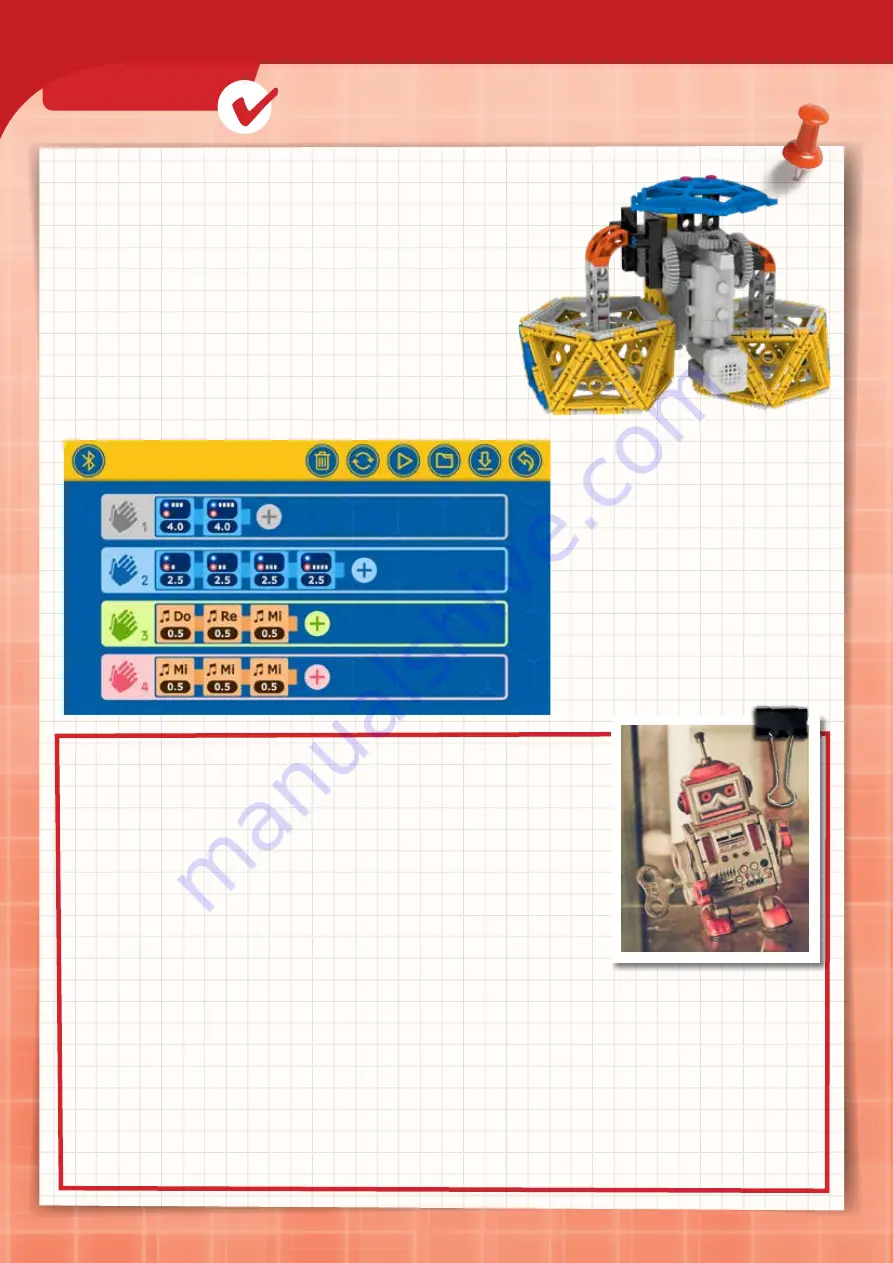
PROGRAMMING
SAMPLE PROGRAM FOR THE BIGFOOT BOT
1. Place the Bigfoot Bot in an open area.
2. Load the app on your tablet or smartphone and establish a
Bluetooth connection between the app and the robot. Refer back to
page 7 for instructions.
3. In programming mode, load
Program 3. The command sequences
shown below are preset in Program 3. Tap the run button and clap
your hands one to four times near the sound sensor.
4. Observe how the robot behaves for each sequence!
PROGRAM 3
1 Clap: Go forward, walk faster
2 Claps: Spin head faster and faster
3 Claps: Play a simple song
4 Claps: Play a simple song
Walking Robots
Legged robots are robots that walk on mechanical
limbs. While many robots roll around on wheels —
which are mechanically very efficient — legged
robots have the ability to walk over obstacles and
surfaces that wheeled robots cannot move over.
Legged robots can go places that wheeled robots
cannot. Designing a robot to walk on legs is more
complicated than designing one that rolls on
wheels. The ability for various animals, humans
included, to walk on legs is actually quite a feat of
nature. Robot engineers often look to nature for
inspiration when it comes to designing legged
robots.
Legged robots can have any number of legs. The
more legs, the more stable the robot is. But robots
with fewer legs are more maneuverable. Legged
robots must keep their balance while shifting from
one leg to another. One way this has been
achieved, as with the Bigfoot Bot, is to make the
feet very large so the
center of gravity
always stays above
the foot that is on
the ground. This
keeps the robot from
falling over.
Walking robots also
use sensors like
gyroscopes and accelerometers to tell their
motors how to move in order to stay balanced. It
takes a lot of power to move a robot’s legs, and
when that power comes from heavy battery
packs inside the robot’s body, it can pose quite a
challenge. As batteries get lighter, and sensor
systems get more advanced, it is becoming
increasingly popular for robots to mimic human
and animal walking motion.
34
Summary of Contents for SUPERSPHERE
Page 33: ...18 12 13 14 15 16 17 31 Bigfoot Bot x4 x2...
Page 34: ...19 20 19 32 x2 BIGFOOT BOT Feetdone Fold and connect the shell pieces at the joints...
Page 41: ...39 Front body Back body Penguin Bot 28 29 Side view Side view Frontbodyassemblydone...
Page 42: ...40 PENGUIN BOT 31 x2 motor A motor B Done 30...
Page 45: ...43 30 mm axle 30 mm axle 6 7 8 9 10 11 12 Dancing Bot Front view...
Page 46: ...44 13 x2 13 14 DANCING BOT Wheels done Fold and connect the shell pieces at the joints...
Page 50: ...48 30 mm axle x2 5 9 10 11 6 7 8 HORSESHOE CRAB BOT...
Page 52: ...50 15 16 14 HORSESHOE CRAB BOT...
Page 53: ...51 Horseshoe Crab Bot 18 19 17 Shelldone...
Page 54: ...52 20 motor A motor B Done HORSESHOE CRAB BOT...
Page 57: ...55 Cornhole Bot 9 10 7 8...
Page 58: ...56 CORNHOLE BOT 11 12...
Page 62: ...fold and link the joint Solutions 60 GEOMETRIC SHAPES LESSON 1 2 3 4 5 x4...
Page 64: ...620384 03 190620...














































